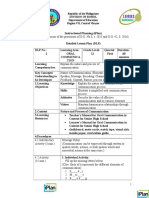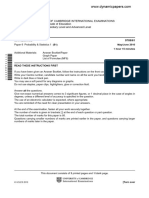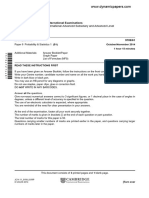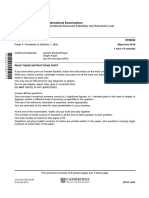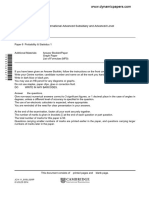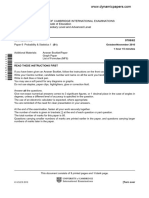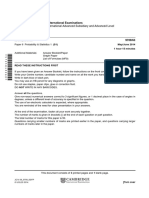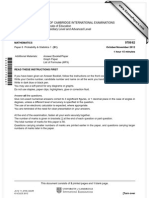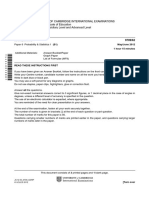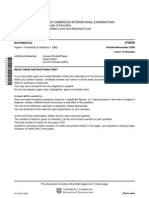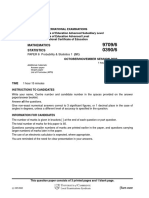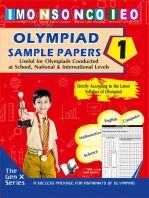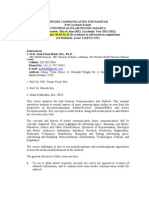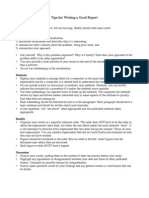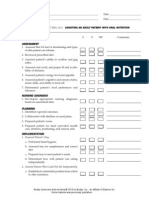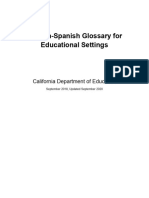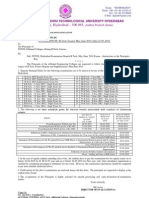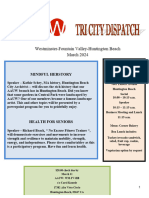University of Cambridge International Examinations General Certificate of Education Advanced Subsidiary Level and Advanced Level
University of Cambridge International Examinations General Certificate of Education Advanced Subsidiary Level and Advanced Level
Uploaded by
Hayati SekerCopyright:
Available Formats
University of Cambridge International Examinations General Certificate of Education Advanced Subsidiary Level and Advanced Level
University of Cambridge International Examinations General Certificate of Education Advanced Subsidiary Level and Advanced Level
Uploaded by
Hayati SekerOriginal Title
Copyright
Available Formats
Share this document
Did you find this document useful?
Is this content inappropriate?
Copyright:
Available Formats
University of Cambridge International Examinations General Certificate of Education Advanced Subsidiary Level and Advanced Level
University of Cambridge International Examinations General Certificate of Education Advanced Subsidiary Level and Advanced Level
Uploaded by
Hayati SekerCopyright:
Available Formats
www.dynamicpapers.
com
UNIVERSITY OF CAMBRIDGE INTERNATIONAL EXAMINATIONS
General Certificate of Education
Advanced Subsidiary Level and Advanced Level
MATHEMATICS 9709/06
Paper 6 Probability & Statistics 1 (S1) May/June 2008
1 hour 15 minutes
Additional Materials: Answer Booklet/Paper
*4683573749*
Graph Paper
List of Formulae (MF9)
READ THESE INSTRUCTIONS FIRST
If you have been given an Answer Booklet, follow the instructions on the front cover of the Booklet.
Write your Centre number, candidate number and name on all the work you hand in.
Write in dark blue or black pen.
You may use a soft pencil for any diagrams or graphs.
Do not use staples, paper clips, highlighters, glue or correction fluid.
Answer all the questions.
Give non-exact numerical answers correct to 3 significant figures, or 1 decimal place in the case of angles in
degrees, unless a different level of accuracy is specified in the question.
The use of an electronic calculator is expected, where appropriate.
You are reminded of the need for clear presentation in your answers.
At the end of the examination, fasten all your work securely together.
The number of marks is given in brackets [ ] at the end of each question or part question.
The total number of marks for this paper is 50.
Questions carrying smaller numbers of marks are printed earlier in the paper, and questions carrying larger
numbers of marks later in the paper.
This document consists of 3 printed pages and 1 blank page.
© UCLES 2008 [Turn over
www.dynamicpapers.com
2
1 The stem-and-leaf diagram below represents data collected for the number of hits on an internet site
on each day in March 2007. There is one missing value, denoted by x.
0 0 1 5 6 (4)
1 1 3 5 6 6 8 (6)
2 1 1 2 3 4 4 4 8 9 (9)
3 1 2 2 2 x 8 9 (7)
4 2 5 6 7 9 (5)
Key: 1 5 represents 15 hits
(i) Find the median and lower quartile for the number of hits each day. [2]
(ii) The interquartile range is 19. Find the value of x. [2]
2 In country A 30% of people who drink tea have sugar in it. In country B 65% of people who drink
tea have sugar in it. There are 3 million people in country A who drink tea and 12 million people in
country B who drink tea. A person is chosen at random from these 15 million people.
(i) Find the probability that the person chosen is from country A. [1]
(ii) Find the probability that the person chosen does not have sugar in their tea. [2]
(iii) Given that the person chosen does not have sugar in their tea, find the probability that the person
is from country B. [2]
3 Issam has 11 different CDs, of which 6 are pop music, 3 are jazz and 2 are classical.
(i) How many different arrangements of all 11 CDs on a shelf are there if the jazz CDs are all next
to each other? [3]
(ii) Issam makes a selection of 2 pop music CDs, 2 jazz CDs and 1 classical CD. How many different
possible selections can be made? [3]
4 In a certain country the time taken for a common infection to clear up is normally distributed with
mean µ days and standard deviation 2.6 days. 25% of these infections clear up in less than 7 days.
(i) Find the value of µ . [4]
In another country the standard deviation of the time taken for the infection to clear up is the same as
in part (i), but the mean is 6.5 days. The time taken is normally distributed.
(ii) Find the probability that, in a randomly chosen case from this country, the infection takes longer
than 6.2 days to clear up. [3]
© UCLES 2008 9709/06/M/J/08
www.dynamicpapers.com
3
5 As part of a data collection exercise, members of a certain school year group were asked how long
they spent on their Mathematics homework during one particular week. The times are given to the
nearest 0.1 hour. The results are displayed in the following table.
Time spent (t hours) 0.1 ≤ t ≤ 0.5 0.6 ≤ t ≤ 1.0 1.1 ≤ t ≤ 2.0 2.1 ≤ t ≤ 3.0 3.1 ≤ t ≤ 4.5
Frequency 11 15 18 30 21
(i) Draw, on graph paper, a histogram to illustrate this information. [5]
(ii) Calculate an estimate of the mean time spent on their Mathematics homework by members of
this year group. [3]
6 Every day Eduardo tries to phone his friend. Every time he phones there is a 50% chance that his
friend will answer. If his friend answers, Eduardo does not phone again on that day. If his friend does
not answer, Eduardo tries again in a few minutes’ time. If his friend has not answered after 4 attempts,
Eduardo does not try again on that day.
(i) Draw a tree diagram to illustrate this situation. [3]
(ii) Let X be the number of unanswered phone calls made by Eduardo on a day. Copy and complete
the table showing the probability distribution of X . [4]
x 0 1 2 3 4
P(X = x) 1
4
(iii) Calculate the expected number of unanswered phone calls on a day. [2]
7 A die is biased so that the probability of throwing a 5 is 0.75 and the probabilities of throwing a 1, 2,
3, 4 or 6 are all equal.
(i) The die is thrown three times. Find the probability that the result is a 1 followed by a 5 followed
by any even number. [3]
(ii) Find the probability that, out of 10 throws of this die, at least 8 throws result in a 5. [3]
(iii) The die is thrown 90 times. Using an appropriate approximation, find the probability that a 5 is
thrown more than 60 times. [5]
© UCLES 2008 9709/06/M/J/08
www.dynamicpapers.com
4
BLANK PAGE
Permission to reproduce items where third-party owned material protected by copyright is included has been sought and cleared where possible. Every reasonable
effort has been made by the publisher (UCLES) to trace copyright holders, but if any items requiring clearance have unwittingly been included, the publisher will
be pleased to make amends at the earliest possible opportunity.
University of Cambridge International Examinations is part of the Cambridge Assessment Group. Cambridge Assessment is the brand name of University of
Cambridge Local Examinations Syndicate (UCLES), which is itself a department of the University of Cambridge.
9709/06/M/J/08
You might also like
- EN11-12-OC-Ia-2 ClamosaDocument7 pagesEN11-12-OC-Ia-2 ClamosaJoseph Superable100% (1)
- June 2008 QP - S1 CIE Maths A-LevelDocument4 pagesJune 2008 QP - S1 CIE Maths A-LevelSoniaNo ratings yet
- 22 - June 2003 QPDocument4 pages22 - June 2003 QPAhmed AliNo ratings yet
- University of Cambridge International Examinations General Certificate of Education Advanced Subsidiary Level and Advanced LevelDocument4 pagesUniversity of Cambridge International Examinations General Certificate of Education Advanced Subsidiary Level and Advanced LevelHayati SekerNo ratings yet
- Mathematics StatisticsDocument4 pagesMathematics StatisticsmarryNo ratings yet
- Mathematics Statistics (S1)Document4 pagesMathematics Statistics (S1)Hayati SekerNo ratings yet
- Cambridge International Advanced Subsidiary and Advanced LevelDocument4 pagesCambridge International Advanced Subsidiary and Advanced LevelHayati SekerNo ratings yet
- University of Cambridge International Examinations General Certificate of Education Advanced Subsidiary Level and Advanced LevelDocument4 pagesUniversity of Cambridge International Examinations General Certificate of Education Advanced Subsidiary Level and Advanced Levelroukaiya_peerkhanNo ratings yet
- Cambridge International Advanced Subsidiary and Advanced LevelDocument4 pagesCambridge International Advanced Subsidiary and Advanced LevelbababassimNo ratings yet
- Cambridge International Advanced Subsidiary and Advanced LevelDocument4 pagesCambridge International Advanced Subsidiary and Advanced LevelV-academy MathsNo ratings yet
- 9709 w15 QP 61Document4 pages9709 w15 QP 61yuke kristinaNo ratings yet
- 9709 s11 QP 62 PDFDocument4 pages9709 s11 QP 62 PDFSzeYee OonNo ratings yet
- University of Cambridge International Examinations General Certificate of Education Advanced Subsidiary Level and Advanced LevelDocument4 pagesUniversity of Cambridge International Examinations General Certificate of Education Advanced Subsidiary Level and Advanced LevelMaitaishe GoraNo ratings yet
- 9709 s12 QP 61 PDFDocument4 pages9709 s12 QP 61 PDFVeronica MardonesNo ratings yet
- 9709 s13 QP 61-MergedDocument732 pages9709 s13 QP 61-MergedAdithyaNo ratings yet
- University of Cambridge International Examinations General Certificate of Education Advanced Subsidiary Level and Advanced LevelDocument4 pagesUniversity of Cambridge International Examinations General Certificate of Education Advanced Subsidiary Level and Advanced LevelHayati SekerNo ratings yet
- 9709 s16 QP 62Document4 pages9709 s16 QP 62Raisa Binte HudaNo ratings yet
- 9709_s14_qp_62Document4 pages9709_s14_qp_62Hiba HassanNo ratings yet
- Stats (s1) As LevelDocument598 pagesStats (s1) As LevelyashviNo ratings yet
- University of Cambridge International Examinations General Certificate of Education Advanced Subsidiary Level and Advanced LevelDocument4 pagesUniversity of Cambridge International Examinations General Certificate of Education Advanced Subsidiary Level and Advanced Levelagnesasus123No ratings yet
- Stat and ProbabilityDocument20 pagesStat and ProbabilityChamika TNo ratings yet
- University of Cambridge International Examinations General Certificate of Education Advanced Subsidiary Level and Advanced LevelDocument4 pagesUniversity of Cambridge International Examinations General Certificate of Education Advanced Subsidiary Level and Advanced LevelV-academy MathsNo ratings yet
- Cambridge International Advanced Subsidiary and Advanced LevelDocument4 pagesCambridge International Advanced Subsidiary and Advanced LevelBassem Khalid YasseenNo ratings yet
- Cambridge International Advanced Subsidiary and Advanced LevelDocument4 pagesCambridge International Advanced Subsidiary and Advanced LevelHayati SekerNo ratings yet
- University of Cambridge International Examinations General Certificate of Education Advanced Subsidiary Level and Advanced LevelDocument4 pagesUniversity of Cambridge International Examinations General Certificate of Education Advanced Subsidiary Level and Advanced LevelMuhammad InamNo ratings yet
- Grade 10 T3 Test FinalDocument9 pagesGrade 10 T3 Test Finalbmodukanele01No ratings yet
- Cambridge International Advanced Subsidiary and Advanced LevelDocument4 pagesCambridge International Advanced Subsidiary and Advanced LevelKelvin SerimweNo ratings yet
- Mathematics StatisticsDocument4 pagesMathematics StatisticsTheresa ArthurNo ratings yet
- 9709 w02 QP 6Document4 pages9709 w02 QP 6michael hengNo ratings yet
- Mathematics StatisticsDocument4 pagesMathematics StatisticsIqra JawedNo ratings yet
- 9709 s14 QP 63Document4 pages9709 s14 QP 63hhvjyuiNo ratings yet
- Cambridge International Advanced Subsidiary and Advanced LevelDocument4 pagesCambridge International Advanced Subsidiary and Advanced LevelLaura Higueras GómezNo ratings yet
- 9709 s14 QP 61Document4 pages9709 s14 QP 61hhvjyuiNo ratings yet
- University of Cambridge International Examinations General Certificate of Education Advanced Subsidiary Level and Advanced LevelDocument4 pagesUniversity of Cambridge International Examinations General Certificate of Education Advanced Subsidiary Level and Advanced LevelVeronica MardonesNo ratings yet
- University of Cambridge International Examinations General Certificate of Education Advanced LevelDocument4 pagesUniversity of Cambridge International Examinations General Certificate of Education Advanced LevelFrankschoolNo ratings yet
- University of Cambridge International Examinations General Certificate of Education Advanced Subsidiary Level and Advanced LevelDocument4 pagesUniversity of Cambridge International Examinations General Certificate of Education Advanced Subsidiary Level and Advanced LevelZaid NaveedNo ratings yet
- Mathematics StatisticsDocument4 pagesMathematics StatisticsHayati SekerNo ratings yet
- Cambridge International Advanced Subsidiary and Advanced LevelDocument4 pagesCambridge International Advanced Subsidiary and Advanced LevelHayati SekerNo ratings yet
- 9709 w12 QP 62Document4 pages9709 w12 QP 62Aj AgenNo ratings yet
- 9709 s10 QP 63Document4 pages9709 s10 QP 63Hubbak KhanNo ratings yet
- University of Cambridge International Examinations General Certificate of Education Advanced Subsidiary Level and Advanced LevelDocument4 pagesUniversity of Cambridge International Examinations General Certificate of Education Advanced Subsidiary Level and Advanced LevelHayati SekerNo ratings yet
- Merged OCR StatsDocument57 pagesMerged OCR StatsKoirala PrijunNo ratings yet
- University of Cambridge International Examinations General Certificate of Education Advanced Subsidiary Level and Advanced LevelDocument4 pagesUniversity of Cambridge International Examinations General Certificate of Education Advanced Subsidiary Level and Advanced LevelVeronica MardonesNo ratings yet
- 0580 w16 QP 32Document16 pages0580 w16 QP 32Aroon ChangNo ratings yet
- 9709 s13 QP 73 PDFDocument4 pages9709 s13 QP 73 PDFDiksha KoossoolNo ratings yet
- University of Cambridge International Examinations General Certificate of Education Advanced Subsidiary Level and Advanced LevelDocument4 pagesUniversity of Cambridge International Examinations General Certificate of Education Advanced Subsidiary Level and Advanced LevelHayati SekerNo ratings yet
- ST130 Final Exam S1, 2010Document8 pagesST130 Final Exam S1, 2010Chand DivneshNo ratings yet
- 9709 w05 QP 6Document4 pages9709 w05 QP 6Basil El GoharyNo ratings yet
- 0580 w18 QP 32 PDFDocument16 pages0580 w18 QP 32 PDFHilmar AlfianNo ratings yet
- Cambridge International Advanced Subsidiary and Advanced LevelDocument4 pagesCambridge International Advanced Subsidiary and Advanced Leveljunk filesNo ratings yet
- 9709 w08 QP 6Document4 pages9709 w08 QP 6Str33tRulerNo ratings yet
- Maths IntegrationDocument7 pagesMaths IntegrationAli Haider (Ali)No ratings yet
- Mathematics Statistics: PAPER 6 Probability & Statistics 1 (S1)Document4 pagesMathematics Statistics: PAPER 6 Probability & Statistics 1 (S1)Ronald McdonaldNo ratings yet
- November 2011 (v2) QP - S1Document4 pagesNovember 2011 (v2) QP - S1bidush dahalNo ratings yet
- Mathematics P3 Feb-March 2014 EngDocument11 pagesMathematics P3 Feb-March 2014 Engaleck mthethwaNo ratings yet
- Revision Guide Foundation Statistics WorksheetDocument5 pagesRevision Guide Foundation Statistics Worksheetsalah.malikNo ratings yet
- MathematicsDocument4 pagesMathematicsHayati SekerNo ratings yet
- Olympiad Sample Paper 3: Useful for Olympiad conducted at School, National & International levelsFrom EverandOlympiad Sample Paper 3: Useful for Olympiad conducted at School, National & International levelsRating: 1 out of 5 stars1/5 (1)
- ACT Math Section and SAT Math Level 2 Subject Test Practice Problems 2013 EditionFrom EverandACT Math Section and SAT Math Level 2 Subject Test Practice Problems 2013 EditionRating: 3 out of 5 stars3/5 (3)
- Olympiad Sample Paper 1: Useful for Olympiad conducted at School, National & International levelsFrom EverandOlympiad Sample Paper 1: Useful for Olympiad conducted at School, National & International levelsRating: 5 out of 5 stars5/5 (1)
- SAT Math Level 2 Subject Test Practice Problems 2013 EditionFrom EverandSAT Math Level 2 Subject Test Practice Problems 2013 EditionRating: 1 out of 5 stars1/5 (1)
- 29-39.dimova Vol.63 PDFDocument11 pages29-39.dimova Vol.63 PDFLaura Nicoleta BorhanNo ratings yet
- PLC Feedback FormDocument1 pagePLC Feedback Formapi-193719531No ratings yet
- Business Organization and ManagementDocument6 pagesBusiness Organization and Managementshelou_domantay100% (1)
- Ma: Mcgill University PHD: University of Quebec at Montreal Post Doctoral: Mcgill University, Montreal, CanadaDocument10 pagesMa: Mcgill University PHD: University of Quebec at Montreal Post Doctoral: Mcgill University, Montreal, CanadaRatriYubeSeiranNo ratings yet
- Closing-The-Gapactionplan Office ReferralsDocument2 pagesClosing-The-Gapactionplan Office Referralsapi-364245985No ratings yet
- Tips For Writing A Good ReportDocument2 pagesTips For Writing A Good ReportKelly Low100% (1)
- Census of Population and Housing 2012 Sri LankaDocument246 pagesCensus of Population and Housing 2012 Sri Lankalkwriter50% (2)
- Word With GH That Sounds G - Google SearchDocument1 pageWord With GH That Sounds G - Google Searchodebowaleoyindamola222No ratings yet
- Regional Office Iv-B Mimaropa: AppealDocument5 pagesRegional Office Iv-B Mimaropa: Appealbethelfaith100% (1)
- 2.2016년 필리핀 교육부 초등학교 등록현황 (지역별) -사립Document2,220 pages2.2016년 필리핀 교육부 초등학교 등록현황 (지역별) -사립이도연No ratings yet
- Assisting Adult Patient With Oral NutritionDocument2 pagesAssisting Adult Patient With Oral NutritionJoslyn GrossNo ratings yet
- Exploratory Course - Computer Hardware Servicing For G 7and 8Document104 pagesExploratory Course - Computer Hardware Servicing For G 7and 8Sirossi Ven100% (1)
- Eid - Al-Adha: Army Public School, Dhaula Kuan UT1/PT1 (2021-22)Document1 pageEid - Al-Adha: Army Public School, Dhaula Kuan UT1/PT1 (2021-22)Raj PandeyNo ratings yet
- Glosario Ingles Espanol para Entornos Educativos Del CDEDocument34 pagesGlosario Ingles Espanol para Entornos Educativos Del CDEoscar fernandezNo ratings yet
- Monitoring Reports SampleDocument34 pagesMonitoring Reports SampleJeryn Ritz Mara HeramizNo ratings yet
- Project ProposalDocument3 pagesProject ProposalKrishian Erl AndogNo ratings yet
- B.tech. Suppl Notification JNTU HYDERABAD (2010) - JntuforumDocument5 pagesB.tech. Suppl Notification JNTU HYDERABAD (2010) - JntuforumjntuforumNo ratings yet
- Volume 106, Issue 18Document20 pagesVolume 106, Issue 18The TechniqueNo ratings yet
- X Maths (Basic) Pre-Board Paper 1Document11 pagesX Maths (Basic) Pre-Board Paper 1nirmalasejwal12No ratings yet
- Gmail - Correction On Scholarship Email - Hours To EnrollDocument3 pagesGmail - Correction On Scholarship Email - Hours To EnrollWilliam DoveNo ratings yet
- Can Different Types of Animation Enhance Recall and Transfer of Knowledge? A Case Study On A Computer Science SubjectDocument12 pagesCan Different Types of Animation Enhance Recall and Transfer of Knowledge? A Case Study On A Computer Science SubjectPUSAT PEMBANGUNAN AKADEMIKNo ratings yet
- Observation DisciplineDocument2 pagesObservation Disciplineapi-339755622No ratings yet
- BTEC HNDs Research ProjectDocument3 pagesBTEC HNDs Research Projectkillu87No ratings yet
- French Igcse Exam PaperDocument18 pagesFrench Igcse Exam PaperdinarwinaNo ratings yet
- Request For Committee Appointment FormDocument2 pagesRequest For Committee Appointment Formtristero312No ratings yet
- Ballroom Dance For Grade 9Document2 pagesBallroom Dance For Grade 9Jhemir JeresanoNo ratings yet
- Ucsap Week 5Document5 pagesUcsap Week 5DAISY SALLEVANo ratings yet
- March 2024 NewsletterDocument10 pagesMarch 2024 Newsletterapi-723159945No ratings yet
- 2022 Jce Summary of Provisional Results Final Report Final 2022Document43 pages2022 Jce Summary of Provisional Results Final Report Final 2022Wä møxãvá grætérkíørkzñ KìddâNo ratings yet
